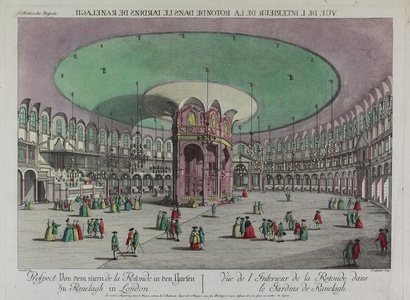| Method | Copper engraving with original hand colouring |
| Artist | Balthazar Friedrich Leizel after Canaletto |
| Published | Se vend a Ausbourg au Negoce comun de l'Academie Imperiale d'Empire sous son Priviledge et avec defense ni d'en faire ni de vendre les Copies [c. 1754] |
| Dimensions | Image 272 x 407 mm, Plate 320 x 433 mm, Sheet 378 x 504 mm |
| Notes |
A vue d'optique of the rotunda at the Ranelagh Gardens in Chelsea, London. The gardens still exist, albeit on a smaller scale than the historic pleasure gardens. The rotunda or "chinese pavilion" was built in the gardens as a venue for concerts and other entertainments, and was opened in 1741, closed in 1803 and finally demolished in 1805. The title is given in German and French below the image, and the French inscription: 'Vue de l'Interieure de la Rotonde dans le Iardins de Ranelagh' in reverse above the image. Perspective views, or vue d'optiques, are a special type of popular print published in Europe during the eighteenth century. These prints were a form of entertainment meant to be seen through devices called "optical machines," "optiques," "zograscopes" or "peepshows." The prints were exhibited by travelling showmen in the streets throughout Europe and also were collected by those in the professional and upper classes who had the optical machines at home. There was a great curiosity about the appearance of unvisited European cities and exotic locations in the further reaches of the globe, and these prints were one of the only ways the general public could get a look at the wider world. When displayed in the optique, the prints were able to transport the viewer into a far away place-an unknown city, or perhaps into the midst of a dramatic bit of contemporary history or to the distant past. The optical machines used for these prints had a lens which enhanced for viewers the magnification and perception of three-dimensional depth of the scenes depicted. A mirror was often used so that the perspective prints could be viewed when laid flat, and in these cases the images were viewed in reverse. It is therefore not unusual that the scenes shown were drawn in reverse, and there is also often a title printed in reverse along the top, allowing the viewers to quickly read the title. There was usually further text at the bottom of the prints, often in several languages, which could be read by the operator of the optique for the benefit of his audience. The most characteristic feature of the perspective views is their emphasised linear perspective, done to further intensify the enhanced appearance of depth and illusionistic space in the prints when viewed through an optique. Another attribute of these prints is their bright, often crude hand colouring, applied boldly so to show the tints when viewed through the lens. The prints usually have a series of colours-blue, pink and yellow are common-crossing in bands from side to side, with bright highlights often including red. These cheerful and colourful images, with their fascinating history and peculiar appearance, make for unusual and appealing eighteenth-century prints. Giovanni Antonio Canal, known colloquially as Canaletto (18th October 1697 - 19th April 1768) was an Italian painter and printmaker. Canaletto is celebrated as the master of Venetian vedute, being one of the most popular artists for British aristocrats on the Grand Tour. Canaletto's major inspiration were the Roman vedute and capricci of Giovanni Paolo Pannini. Although best known for his paintings, Canaletto also produced a number of etchings, including a series of 30 plates of Venice and its surrounds. The interest in Canaletto's work in Britain was great, spurred by the collections of various British nobles, and especially by George III, who amassed a significant number for the Royal Collection. As a result, prints of Canaletto's vedute were in high demand. Balthasar Friedrich Leizel or Leizelt (fl. 1760-1799) was a German printmaker, active in Ausburg. Condition: Good impression with wide margins. Minor overall creasing, one vertical crease to centre. Time toning and surface dirt built-up to edges of the sheet. |
| Framing | unmounted |
| Price | £180.00 |
| Stock ID | 47073 |

